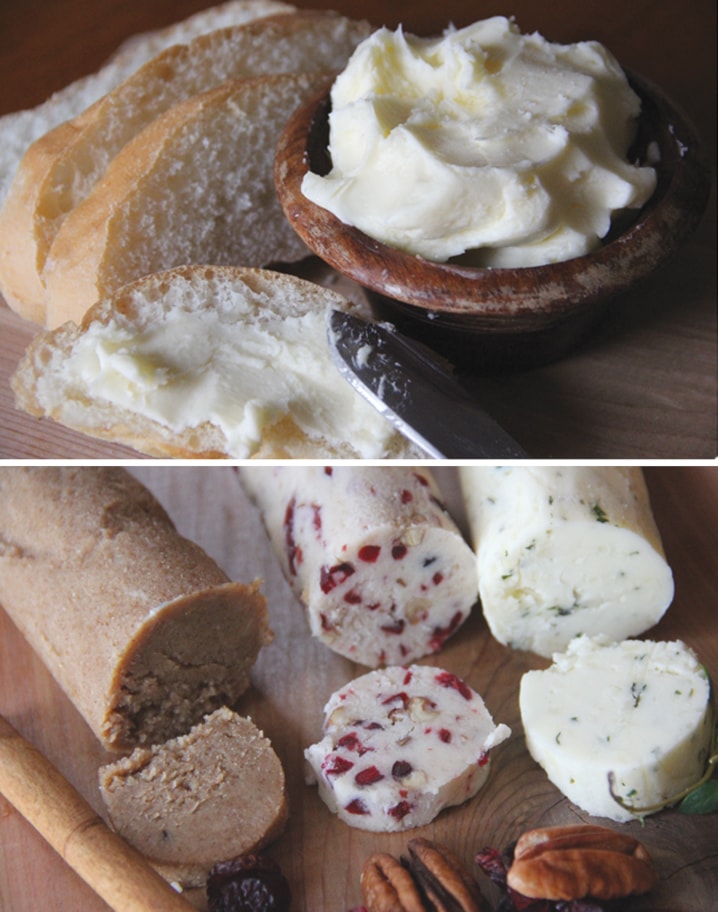Butter. It probably is one of the easiest things to make.
You might ask: “Why make homemade butter?”
But really, the question should be: “Why not?”
Fresh-made butter has a rich, glossy texture that’s silky, not waxy.
But it’s not just about texture. Unlike most supermarket brands of butter, homemade butter has noticeable flavour: fresh, lightly sweet and extremely, well, buttery! Once you whip up your first batch, you will realize that homemade trumps the best and fanciest store-bought premium butters.
Don’t have a churn to make butter? Well there is no need. I am about to reveal to you an ancient butter-making secret; besides cream, all that is required to make butter is shaking, shaking, shaking and more shaking. How you do this, is up to you!
I first remember making butter in elementary school — shaking a jar of cream that we passed around the classroom. Once it started to sound thumpy in the jar instead of splashy, we opened the jar to find yellow butter separated from the milky liquid.
In the kitchen, you can very easily prepare butter using your food processor, blender or mixer. Pour the cream into a bowl, set the electric mixer on medium speed and blend. The thick white cream transforms from a fluffy whipped cream, to a soft cottage-cheese-like curd and finally to pale yellow butter that stiffens and clumps together. This should take about 10 minutes.
Once the butter is formed, stop the mixer and carefully strain off as much buttermilk as you can into an airtight container. But before putting into the refrigerator, take a sip — this is probably one of the best tasting buttermilks you’ll ever have. Unlike the thick and tangy buttermilk you’ll find in the market, this has skim milk-like thinness, and is sweet and refreshing. If you can resist gulping the whole thing, it can be used in your cooking and baking.
Use a spatula to press the butter to squeeze out as much of the liquid as possible. Add about half a cup of ice water to the butter and use the spatula to press the butter and water against the side of the bowl. This step, called washing, is important to help remove the excess buttermilk, which will make the butter go rancid faster. Pour off the cloudy liquid and add more ice water and repeat the process two or three times until the water becomes less cloudy.
Once the washing is complete, continue kneading butter against the side of the bowl until all the liquid has been pressed out.
You can slather it onto bread at this stage or you can sprinkle with sea salt to up the flavour even more.
Or you can get really creative and delve into the world of compound butters. Compound butter is simply butter with additional flavour and ingredients — it’s the quickest way to add a little flair and fancy to the dinner table.
Stir in fresh herbs, chives, garlic, spices, or even fresh or dried fruits, into softened butter to boost the flavour of grilled fish or steak, steamed vegetables, oven-hot biscuits or fluffy pancakes.
Some savoury combos to try with softened, unsalted butter include lemon zest and snipped parsley, grated Parmesan cheese and fresh basil, or cilantro, lime zest and hot sauce.
For a sweet variety, try roasted pecan, dried cranberries and maple syrup, or cinnamon and brown sugar.
Once you have added your signature flavours to your butter, grab a piece of parchment paper, plop the mixed butter onto it, fold it over and then roll gently back and forth until you have a log shape. Twist the ends and place it into the fridge to set up until firm. Then cut off small coins to serve.
If you want to go crazy, you could even cut it into fancy shapes after it’s firm with small cookie cutters or press the butter into ice cube trays.
Well-wrapped butter will stay fresh in your refrigerator for a week or two, and in your freezer for at least a month.
Buttermilk will stay fresh for about a week; I’ve never tried freezing it.
When making butter, you’ll get about half as much butter as the amount of cream used, plus residual buttermilk produced by the process. Thus, four cups of cream yields one pound butter with two cups of buttermilk.
If you are still not convince about making your butter at home, here is one point that will have you mixin’ and shakin’: whipping up your butter ensures there are no artificial colours or preservatives, and you get to control the salt and the flavour!
Madhu Badoni is a Red Deer-based freelance food writer. She can be reached at madhubadoni@gmail.com or on Twitter @madhubadoni. Watch for Madhu’s Masala-Mix blog on www.reddeeradvocate.com.
